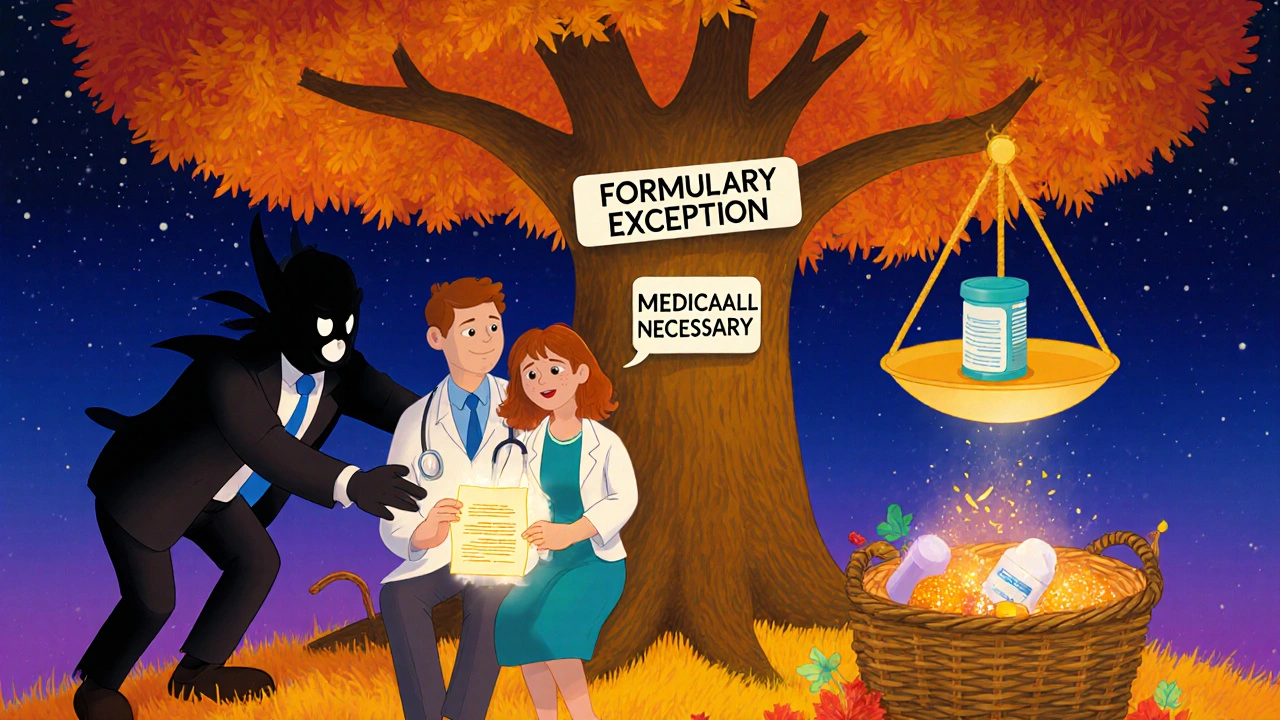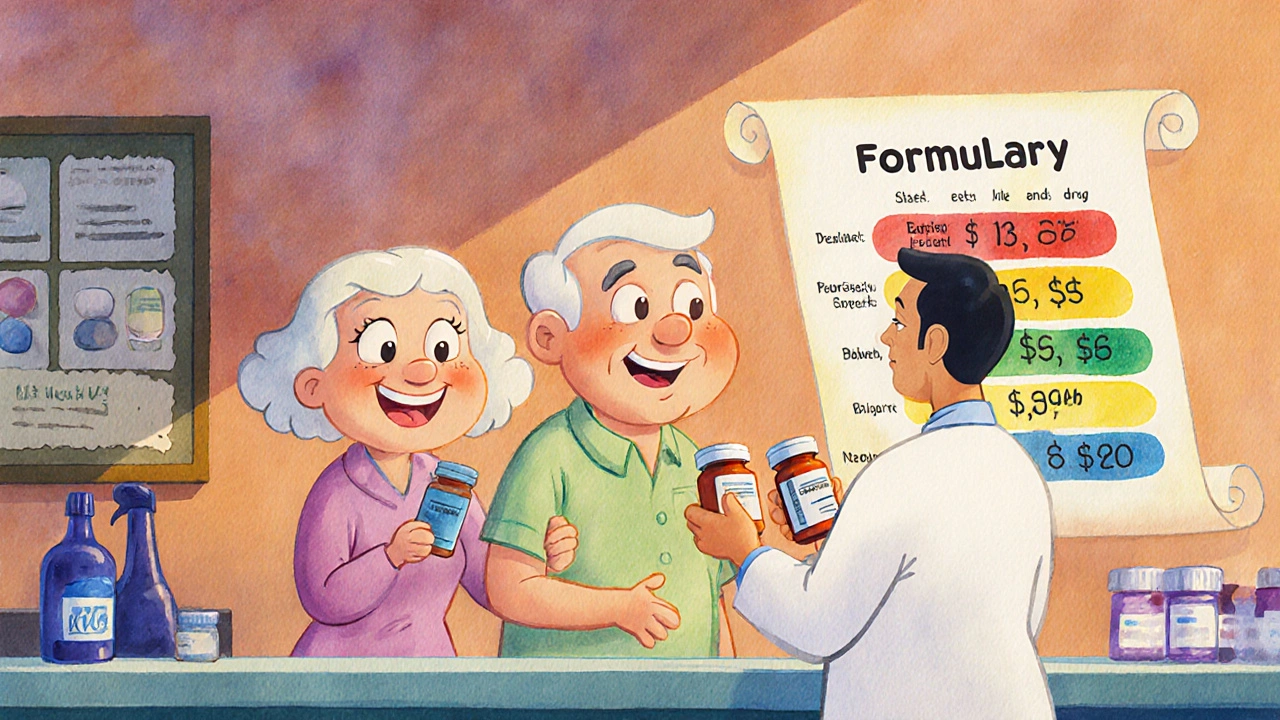When your Medicare Part D plan switches your medication without asking, it’s not a mistake - it’s policy. Many beneficiaries assume their doctor’s prescription is final, but under Medicare Part D, substitution is built into the system. Pharmacists can swap your brand-name drug for a generic. Your plan may require you to try a cheaper drug first. And if your drug gets moved to a higher cost tier, you might suddenly pay double. These aren’t random changes. They’re guided by formularies, cost controls, and federal rules that change every year.
How Medicare Part D Substitution Actually Works
Medicare Part D doesn’t pay for drugs directly. Instead, private insurance companies run the plans, and they decide which drugs are covered and how much you pay. These lists are called formularies. Every plan has one. And every plan is different.
Most Part D plans use a five-tier system:
- Tier 1: Preferred generics (lowest cost)
- Tier 2: Non-preferred generics
- Tier 3: Preferred brand-name drugs
- Tier 4: Non-preferred brand-name drugs
- Tier 5: Specialty drugs (highest cost)
When you walk into the pharmacy, the pharmacist checks your plan’s formulary. If your prescribed drug is on Tier 4, but there’s a generic or preferred brand on Tier 1 or 2, the pharmacist can legally substitute it - unless your doctor wrote "Do Not Substitute" on the prescription. This is called therapeutic substitution. It’s allowed as long as the replacement drug treats the same condition and meets federal safety standards.
But here’s the catch: your plan might not cover the drug you want at all. If your doctor prescribes a drug that’s not on the formulary, you’ll pay full price unless you request an exception. And if your plan removes a drug from its list mid-year, you’ll get a notice - but you’re still responsible for finding a replacement or paying out of pocket until your next enrollment period.
Why Substitution Happens: Cost Control and Formulary Design
Part D substitution isn’t about convenience. It’s about money. The system is designed to push beneficiaries toward lower-cost options. Generic drugs cost 80-85% less than brand-name versions. So plans put generics on the lowest tiers and charge higher coinsurance for brands.
For example, if your plan charges a $10 copay for a preferred generic but 25% coinsurance for a brand-name drug, a $300 medication could cost you $75 - even if it’s medically identical. That’s why 90% of Part D plans encourage substitution through pricing.
Pharmacy Benefit Managers (PBMs) - the middlemen hired by insurance companies - negotiate discounts with drugmakers. In return, they get preferred placement on formularies. A drugmaker might pay a rebate to get its drug on Tier 3 instead of Tier 4. That rebate helps lower premiums for everyone, but it also means your doctor’s favorite drug might get bumped down the list.
This creates a hidden conflict: the drug your doctor trusts might not be the one your plan wants you to use. And unless you check your plan’s formulary before signing up, you could end up paying more - or getting a drug that doesn’t work as well.
The $2,000 Out-of-Pocket Cap Changes Everything in 2025
Before 2025, Medicare had a coverage gap called the "donut hole." Once you spent a certain amount, you paid 100% of drug costs until you hit a threshold. That made substitution a survival tactic - switch to cheaper drugs to avoid hitting the gap.
That’s gone. Thanks to the Inflation Reduction Act, as of January 1, 2025, you stop paying out-of-pocket once you’ve spent $2,000 on covered drugs for the year. After that, you enter catastrophic coverage - and you pay nothing for the rest of the year.
This changes substitution behavior. Before, people rushed to switch to generics to avoid the gap. Now, if you’re nearing $2,000, you might actually want to stick with your brand-name drug - because once you hit the cap, it’s free. No penalty. No extra cost.
But here’s the twist: the $2,000 cap only applies to what you pay. It doesn’t include what your plan or manufacturer pays. So if your drug costs $500 a month and you pay $125 (25%), you’re still building toward the cap. But if your plan switches you to a $50 generic and you pay $10, you’re only adding $10 toward your cap. That means you’ll hit the $2,000 limit slower - and stay in the coinsurance phase longer.
Substitution isn’t just about saving money anymore. It’s about how fast you reach the cap. And that’s something you need to track.
What You Can Do: Protect Yourself From Unwanted Substitutions
You have rights. You just need to know them.
- Check your plan’s formulary before you enroll. Don’t assume your current drugs are covered. Use Medicare’s Plan Finder tool or call your plan directly. Ask: "Is [drug name] on the formulary? What tier? Is there a generic alternative?"
- Ask your doctor to write "Do Not Substitute" on prescriptions. This blocks the pharmacist from swapping your drug - but only if your doctor agrees it’s medically necessary.
- Request a formulary exception. If your drug was removed or moved to a higher tier, you can ask your plan to cover it anyway. You’ll need a letter from your doctor explaining why the alternative won’t work.
- Use the annual enrollment period. From October 15 to December 7, you can switch plans. If your drug was dropped or got more expensive, this is your chance to move to a plan that covers it better.
- Track your spending. Keep receipts. Know how much you’ve paid so far this year. If you’re close to $2,000, you might want to hold off on switching drugs until after you hit the cap.
Many people don’t realize their plan can change its formulary at any time - even mid-year. You’ll get a notice if a drug you take is being removed or moved to a higher tier. But if you don’t read your mail, you won’t know until you get to the pharmacy and get a surprise bill.
Special Cases: Insulin, High-Cost Drugs, and Dual Coverage
Some drugs have special rules. For example, in 2025, insulin costs no more than $35 for a 30-day supply under any Part D plan. That’s a hard cap - no matter what tier it’s on. So if you take insulin, substitution doesn’t matter as much. You pay the same.
Other high-cost drugs - like those for cancer or multiple sclerosis - may have different rules. Some plans require you to try a less expensive drug first (called step therapy). Others require prior authorization before they’ll cover it. These aren’t substitutions - they’re gatekeeping. But they have the same effect: you can’t get your preferred drug without jumping through hoops.
If you have other insurance - like from a former employer - you need to be careful. Enrolling in Part D might cause you to lose your existing drug coverage permanently. Some retiree plans don’t coordinate with Medicare. Always check with your benefits administrator before switching.

What’s Coming in 2026
The $2,000 out-of-pocket cap is rising to $2,100 in 2026. That means you’ll have to spend a little more before you hit catastrophic coverage. But the structure stays the same: no more donut hole, no more unlimited costs.
Plans are also getting fewer choices. In 2025, there were 14 stand-alone Part D plans available on average. That’s down 52% from a decade ago. Meanwhile, Medicare Advantage plans with drug coverage (MA-PDs) have grown by 143%. That means more people are getting drug coverage through bundled plans - and those plans often have tighter formularies and stricter substitution rules.
Don’t assume next year will be the same. The Centers for Medicare & Medicaid Services (CMS) releases new guidelines every year. The 2026 rules are already in draft form. Substitution policies will keep changing. So will your costs.
Bottom Line: Know Your Plan, Know Your Drugs
Medicare Part D substitution isn’t a glitch. It’s the system working as designed. The goal is to reduce costs - but the burden falls on you. If you don’t understand your formulary, you’ll pay more. If you don’t track your spending, you might miss the $2,000 cap. If you don’t check your plan every year, you could wake up in 2026 with no coverage for your medication.
Take 20 minutes before open enrollment. List your drugs. Check your plan’s formulary. Call your pharmacist. Ask questions. Don’t wait until you’re at the counter with a $200 bill. The system is built to push you toward cheaper options. But you’re the one who pays the price - unless you fight back with information.
Can my pharmacist switch my Medicare Part D drug without telling me?
Yes, if your doctor didn’t write "Do Not Substitute" on the prescription and your plan allows it. Pharmacists can swap your brand-name drug for a generic or another drug in the same class if it’s on your plan’s formulary. But they must tell you before dispensing the substitute - and you have the right to refuse it and pay the higher price for your original drug.
Why does my drug cost more this year even though it’s the same?
Your plan likely moved your drug to a higher tier on its formulary. This can happen mid-year. For example, a drug that was on Tier 3 (preferred brand) might be moved to Tier 4 (non-preferred), raising your coinsurance from 25% to 40%. You’ll get a notice in the mail, but many people miss it. Always review your plan’s formulary each fall during open enrollment.
Does the $2,000 out-of-pocket cap include what I pay for non-covered drugs?
No. Only what you pay for drugs on your plan’s formulary counts toward the $2,000 cap. If you pay full price for a drug your plan doesn’t cover - or if you get a non-formulary drug without an exception - that money doesn’t count. Make sure your drugs are covered before you buy them.
What if my doctor says I need a specific drug, but my plan won’t cover it?
You can request a formulary exception. Your doctor must write a letter explaining why the alternative drugs won’t work for you - for example, if you had side effects or it didn’t control your condition. Submit this to your plan. If they deny it, you can appeal. This process can take weeks, so start early.
Can I switch plans if my drug gets removed from the formulary?
Yes - but only during the annual enrollment period (October 15 to December 7) or if you qualify for a Special Enrollment Period. Examples include moving to a new state, losing other coverage, or entering a long-term care facility. If your drug is removed and you don’t qualify for an exception, you’ll have to wait until next year unless you pay out of pocket.

